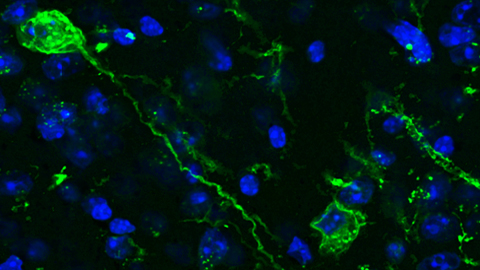UAB Pioneers Study of Memory Through Optogenetics

01/06/2016
Raül Andero Galí, one of the heads of the “Neurobiology of Stress and Addiction” research group at the Institut de Neurociències (INc) of the Universitat Autònoma de Barcelona (UAB) and researcher at Harvard University, published an article in which, for the first time in Spain, optogenetics was used to increase memory.
The technique, tested in mice, consists in the stimulation of a group of neurons in the cerebral amygdala, named Tac2, using a laser. These neurons need to be previously made sensitive to light by introducing a virus in a specific cerebral area. There, the neurons are necessary to store memories related to fear. Mice which received this treatment saw their long-term memory increased and therefore were better at remembering danger.
This is the first time in the world that light stimulation has been used to activate this specific group of memory neurons – in previous studies other types of memory neurons had been stimulated. The study, published in Neuropsychoparhamacology (Nature), helps to understand the mechanism by which fear is learned and represents a large step to finding treatments for fear-related diseases.
“Our discovery stresses the importance of Tac2 neurons in the regulation of fear, and opens the door to new therapeutical targets for the treatment of diseases related to fear such as phobias, obsessive-compulsive disorder and post-traumatic stress disorder. Moreover, it can also help to find new ways to improve the memory of healthy people or people with memory problems”, Raül Andero said.
To reach these conclusions, researchers observed the behavior of two mice populations: one under optogenetics treatment and the other under no treatment. They both were exposed to a tone and then received an unpleasant electrical stimuli. Mice stimulated by optogenetics remembered that the tone preceded the stimuli longer and showed more signs of fear when they heard the tone days after.
The published study is the result of Raul Andero’s work conducted during more than two years at Kerry Ressler’s laboratory in McLean Hospital, Harvard University, and completed at the UAB. Two years ago, Ressler and Andero patented a drug that modulates this type of memory. The drug, and other analogues, may be capable of decreasing the emotional consequences a traumatic event can cause in the future and minimise the risk of suffering mental diseases related to the trauma.
In future studies, Andero and his collaborators will continue to study the cerebral mechanisms by which fear is learned. “Next steps will be to study, by optogenetics, how the amygdala communicates with other parts of the brain also related to fear learning” said the researcher.
The experience using this technique positions the UAB’s Institut de Neurociències as a leading centre in the country and opens the door to multiple international collaborations.
Original article: Andero R, Daniel S, Guo JD, Bruner RC, Seth S, Marvar PJ, Rainnie D, Ressler KJ. Amygdala-Dependent Molecular Mechanisms of the Tac2 Pathway in Fear Learning. Neuropsychopharmacology. 2016 May 26. doi: 10.1038/npp.2016.77. [Epub ahead of print]